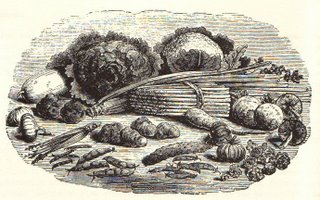Colouring food with various things natural and unnatural has a long history, and not just to give an entire dish a new colour. Sometimes food colouring has been used like paint. There are many references in medieval records of feast dishes decorated to look like heraldic symbols for example. Moving forward to the nineteenth century, in 1846 Alexis Soyer greatly impressed the visiting Pasha of Egypt with an edible portrait on a pineapple cream.
Cream of Egypt à l’lbrahim Pacha … an elegant cream à l’ananas, … What was his Highness's astonishment however, on again looking at the spot, to observe in the cream, as under a glass, a highly-finished portrait of himself, surrounded by a very carefully-executed frame. … “The portrait in the cream is drawn on wafer-paper, which being placed on the damp jelly representing the glass, dissolves, and nothing remains of the wafer-paper but the appearance of the portrait painted in light water-colours. Tbe imitation of the gilt frame is made with the eau de vie of Dantzic and gold water mixed with the jelly, the gold leaf of which forms the frame.” … Though everything was eatable in it, this magnificent dish was respected, and remained untouched until the end of the banquet, though everybody tried to partake of the fruit which surrounded it.
A chef with a truly artistic touch! I do wonder if the ‘light water-colors’ were truly edible however.
Yesterday it was cochineal that caught my eye, but other red colourings that have been used in the past are sandalwood, brazilwood, red fruits such as redcurrants, barberries, and pomegranate juice, or beets, crushed red roses, and alkanat or orchanet (a plant of the borage family). All very natural, as is a another red called vermilion, which comes from the natural mineral cinnabar, and consists of mercuric sulphide, which is a very dangerous natural toxin. Think on this sort of thing next time you find yourself attracted to a package that says ‘all natural’ ingredients. It is a marketing phrase, my friends, nothing more. I doubt that vermilion is used anywhere in food today, as we have Allura Red (E129) instead, and probably others, which is quite unnatural and may or may not be harmful.
It was red yesterday, so it is yellow today. Yellow colourings used in the past are safron, yellow lily, and things such as ‘yellow smalt’ made from natural minerals and used as paint pigment. Today, saffron is so prohibitively expensive that we would not be likely to use it just for colour, and I shudder to think how much this recipe for yellow colouring would cost.
Yellow Colour.
Yellow Colour for the ornamentation of pastry must be prepared by placing an ounce of hay-saffron in a sugar-pan with a gill and a half of water, a small quantity of alum, and half an ounce of sugar. Se the pan on the fire, let the liquid boil for ten minutes, then pass it through a napkin.
Cassell’s Dictionary of Cookery.
(Hay saffron is the crocus stigmas dried in their loose state, not compressed into cakes. It is the most desirable, partly because it is more difficult to adulterate.)
Nowadays, turmeric is a cheaper substitute when a yellow is wanted, and here it is in pickle. - where it very advantageously also adds its flavour. Or is it that it coincidentally adds its colour?
Yellow Pickle.
Take six firm heads of cabbage, take off all the loose leaves, quarter them and dip them separately in a kettle of boiling water; lay them in dishes, and sprinkle them well with salt; lay them in the sun until the water is pretty well drained from them, then dip them separately in strong, boiling vinegar; let them be well saturated. Prepare your spice; an ounce of cinnamon, an ounce of cloves, one of mace, black pepper, orange-peeling, and ginger; let them be all well pounded. Three ounces of white mustard-seed, scald them in vinegar and let them stand and soak at least two hours; a half pound of horseradish, nicely sliced in long narrow pieces, these must be scalded also, as you do the mustard-seed. Then take a stone jar, put in a layer of cabbage, a layer of spice, horseradish, and mustard-seed, and a bag of tumerick, about as large as a hickory nut, then another layer of cabbage, then one of spice, horseradish, mustard-seed, and another bag of tumerick. On the top layer put a bag holding a half ounce of tumerick, then fill up with cold vinegar; have your jar air-tight, and do not disturb it for at least three months; they are always best when undisturbed, for at least a year. I have seen pickles made by this receipt, seven years old, which were delicious. Pickles should always be kept a long time before using them.
The Great Western Cook Book, or Table Receipts, Adapted to Western Housewifery.
Quotation for the Day …
I'm frightened of eggs, worse than frightened, they revolt me. That white round thing without any holes ... have you ever seen anything more revolting than an egg yolk breaking and spilling its yellow liquid? Blood is jolly, red. But egg yolk is yellow, revolting. I've never tasted it. Alfred Hitchcock.
